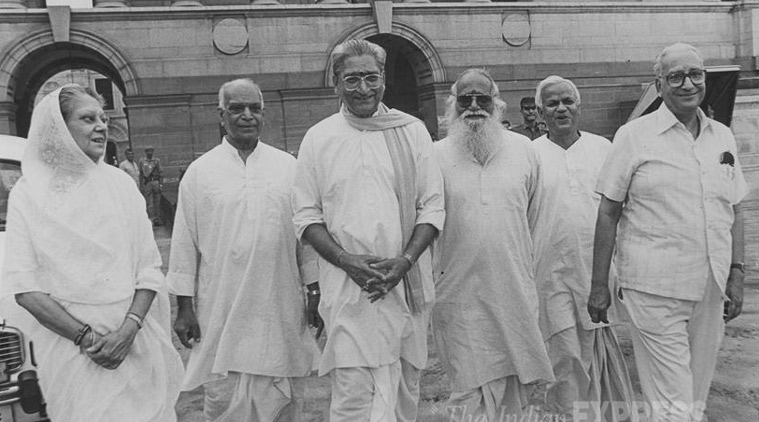
Rajmata Scindia, Ashok Singhal and other leaders of VHP coming out of Rashtrapati Bhawan after meeting the president S.D. Sharma. (Source: Express Archive photo)
With the death of Ashok Singhal, the Sangh Parivar has lost one of its sturdiest pillars. Within the Sangh Parivar he was considered a role model for pracharaks as a man who had identified his mission in life and knew how to achieve it.
Singhal first encountered the RSS while he was studying for a B Tech at Banaras Hindu University (BHU) in the 40s. At the time, Bhau Rao Deoras, brother of the second RSS chief Bala Saheb Deoras was deputed to Uttar Pradesh to recruit young meritorious students at campuses. He made contact with the likes of Singhal at BHU and Rajendra Singh in Allahabad (he was the fourth RSS chief) , and also Atal Behari Vajpayee who was in Kanpur. All these became pracharaks and remained unmarried. Singhal became a pracharak in 1949.
Singhal belonged to a well-to-do family and his palatial bungalow, Mahavir Bhawan in Allahabad, is located just behind the Nehrus’ Anand Bhawan. A portion of the bungalow is a Sanskrit residential school run by the VHP.
His brother BP Singhal was an IPS officer of the 1955 batch and associated himself with the activities of Vishwa Hindu Parishad (VHP) after his retirement in the late eighties. He was elected to Rajya Sabha in 1998 and till his death in 2012 he was associated with the Sanskritik Gaurav Sasthan, an organisation linked to the VHP. BP Singhal was also chief of the Central Board of Film Certification for a year in 1990-91.
While releasing a book on Singhal’s life entitled Ashok Singhal – Hindutva ke Purodha on October 2, RSS chief Mohan Bhagwat said that Singhal’s tenure as prant pracharakof Delhi was an inspiration to other prant pracharaksfor his intensity and versatility. Singhal was famous for bursting into patriotic songs and even at the book release Bhagwat had requested him to sing his favorite `Bharat Puneet Bharat Vishal’ and Singhal had obliged.
In the 1980s Ashok Singhal became a symbol of the Ayodhya movement. He was sent to the VHP by then RSS chief Bala Saheb Deoras in 1981. He launched the Ram Janki Rath Yatra in 1985 and demanded the opening of the locks at Ram Janmabhoomi. When the opening of locks was ordered by the local Faizabad, Singhal’s next step was to launch a movement to built a new temple there.
A key strategist, Singhal gained fame when the chief minister of UP at the time, Mulayam Singh Yadav repeatedly boasted that on the date chosen for kar sewa in Ayodhya in 1990, “Koi parinda bhi par nahi maar sakta (without my permission even birds cannot fly).” The police hunted for Singhal everywhere but he successfully eluded them until he reached Ayodhya in a bus and broke the police barricades.
After LK Advani took over the BJP in the 80s, it joined hands with the RSS fraternity. They took the position that the Ayodhya issue could not be decided by a court, it had to be done either by dialogue or by legislation. The BJP benefited from the Ayodhya movement and in the 1991 elections several sadhus and sanyasis campaigned for the BJP—some fought the elections and even won.
Pracharaks close to Ashok Singhal say that it was Singhal’s movement of aggressive Hindutva that benefitted the BJP. However, when Atal Behari Vajpayee came to power in 1998, Singhal’s voice on the Ram mandir issue was largely ignored. Singhal became more and more critical of the Vajpayee government’s soft stand on the Ram mandir issue.
While Prime Minister Narendra Modi has described Singhal as a “force behind several noble deeds and social work”, and said that his demise was a “deep personal loss”, Singhal had praised the Modi’s victory in the 2014 elections. He had said that it put an end to the 800 years of “slavery,” — it will not remain confined to India but present a new ideology before the world, Singhal had said in a function in Delhi.
Singhal had devoted the second part of his life to the Ram mandir movement and several RSS pracharaks feel that his death is sad and poignant for he did not witness the Ram mandir being built in his lifetime.





